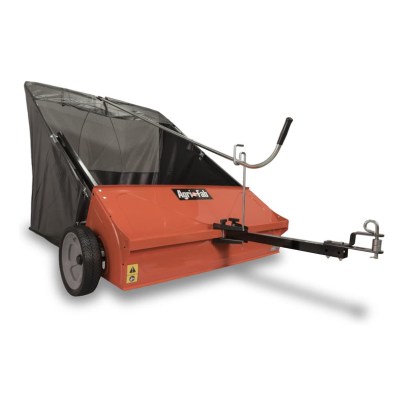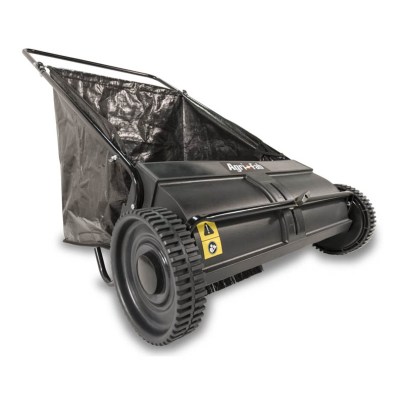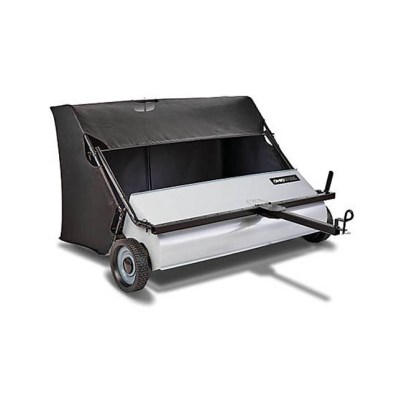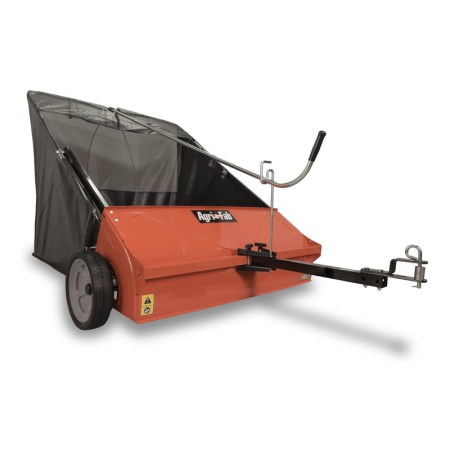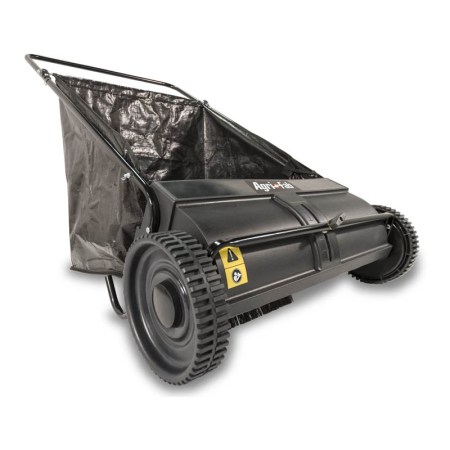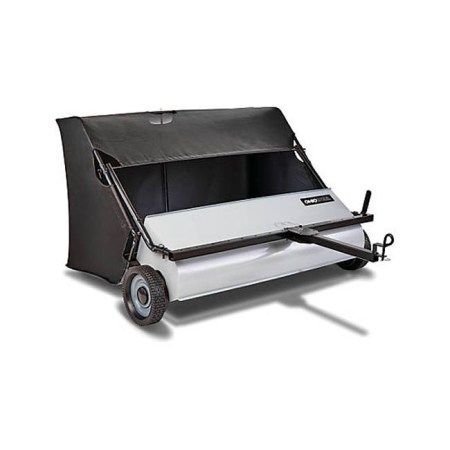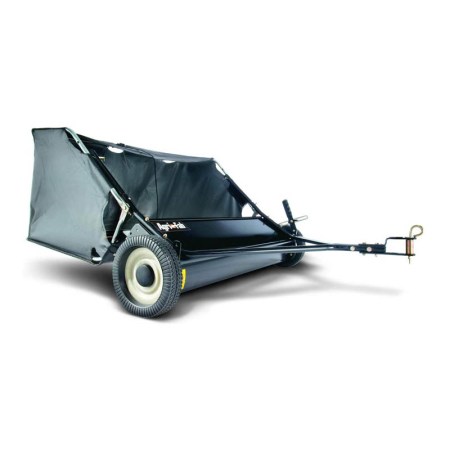We may earn revenue from the products available on this page and participate in affiliate programs. Learn More ›
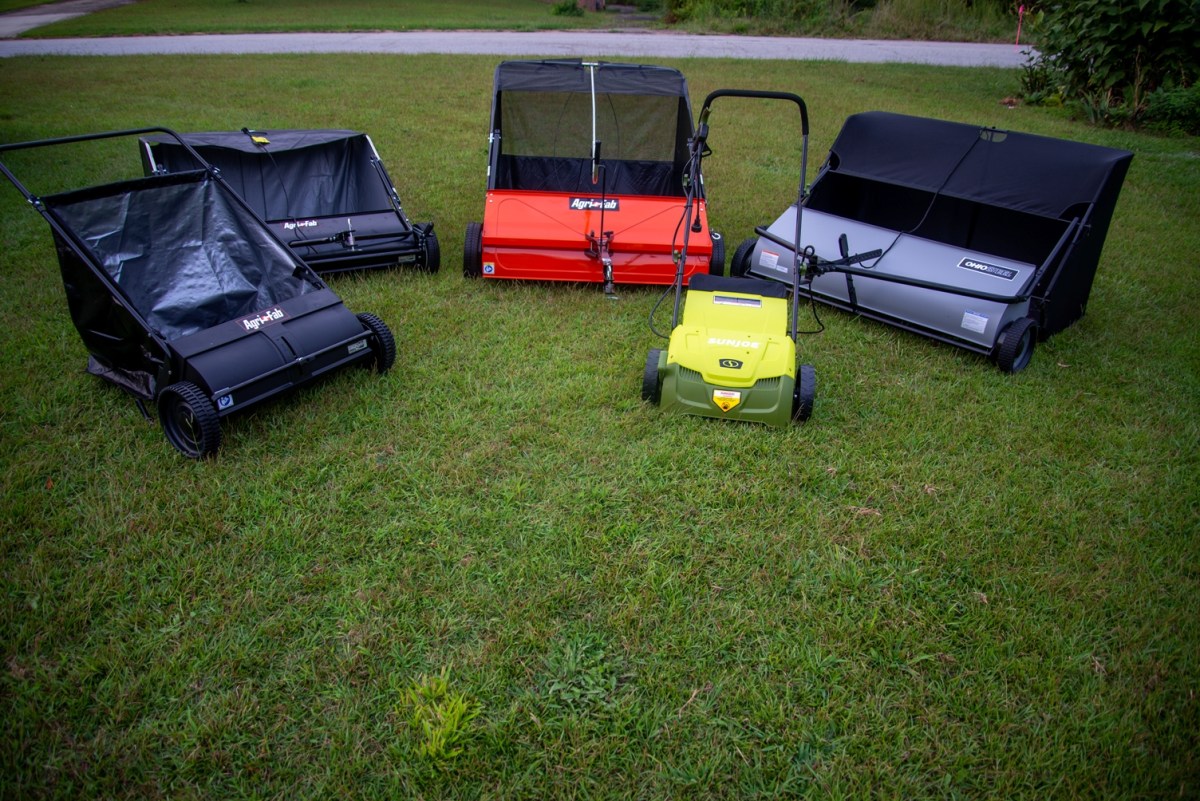
The best lawn sweepers quickly and efficiently gather leaves, grass clippings, and even pine needles, giving your yard a pristine look. The clever machines use cylindrical brushes that reach into the grass to pull out debris, which it then collects in a hopper, making it easy to add the waste to a burn pile or to load into eco-friendly lawn bags.
To choose the right lawn sweeper for your needs, investigate the sweeping path and the hopper capacity as well as the style, features, and durability of models you’re considering. For more in-depth help, keep reading this primer to learn what is usually important to consider. Later on, we will review the best lawn sweepers from our backyard trials. But first, here’s a preview of our picks for some of the best lawn sweepers on the market.
- BEST OVERALL: Agri-Fab 45-0492 Lawn Sweeper
- BEST BANG FOR THE BUCK: Agri-Fab 45-0218 26-Inch Push Lawn Sweeper
- BEST HEAVY DUTY: Ohio Steel 50 in. Lawn Sweeper
- HONORABLE MENTION: Agri-Fab 45-0320 42-Inch Tow Lawn Sweeper
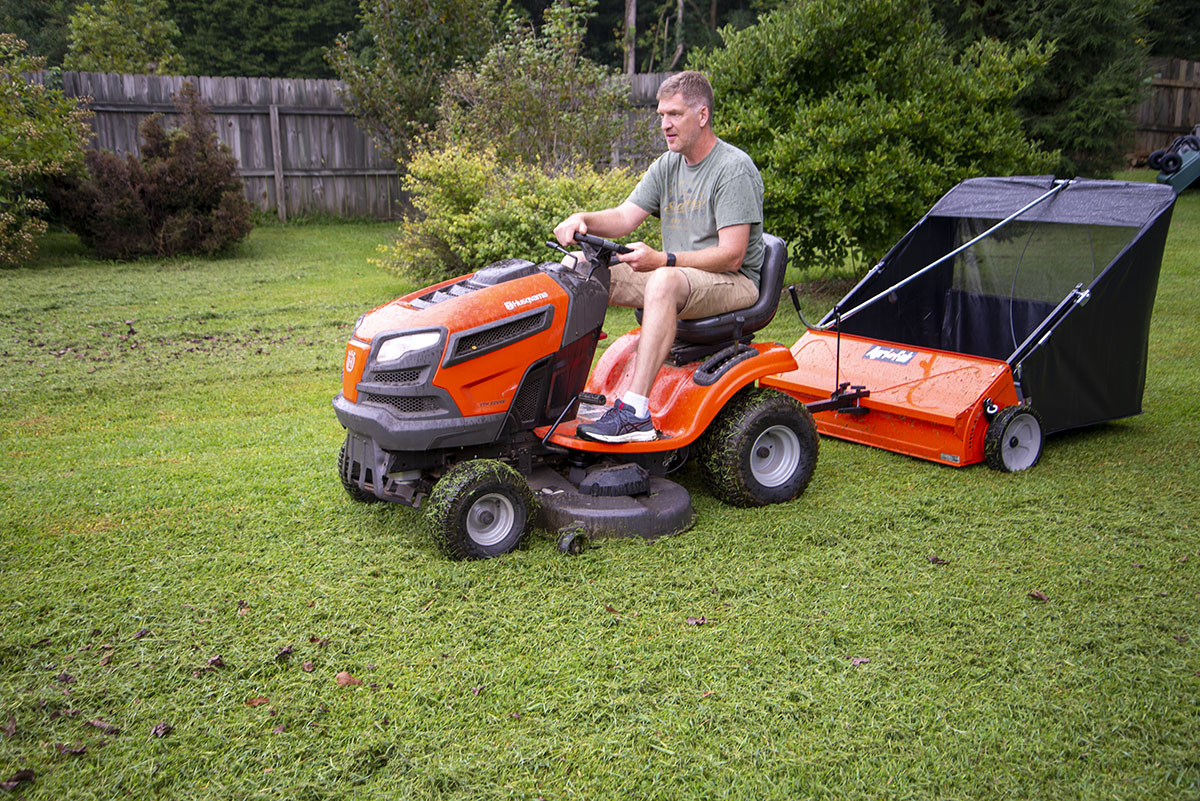
Before You Buy a Lawn Sweeper
Lawn sweepers, also known as leaf sweepers, tend to be best suited to lawns that demand a manicured appearance. But these devices fill up with grass clippings and leaves quickly, particularly in yards with dense foliage. Before fully clearing a denser yard, there are usually frequent stops to empty the hopper, which is a sturdy bag attached to a metal frame that captures debris.
You’ll also need a place to dump the debris, whether it’s beyond a tree line or near a burn pile. Emptying the hopper bag onto the ground and then scooping debris into a lawn waste bag is another option, though it’s far less convenient.
For larger properties that don’t require perfectly manicured yards or properties that have a garden along with a lawn, a riding mower that mulches the leaves and grass to fertilize the land may be the better option.
How We Tested the Best Lawn Sweepers
The sweepers shipped from online retailers, so the testing process began with assembly according to the provided manufacturer’s instructions. To gauge the ability of each unit, we allowed a section of lawn to grow out a bit longer than average.
We picked up larger sticks and other foreign objects, and cleaned up after our dogs as normal before mowing. After mowing, a rain shower wetted the clippings, adding an unexpected real-life element to the test. We then used the sweepers to pick up the wet lawn clippings and other late-summer landscape debris, including some areas of fallen leaves, pine cones, acorns, and more.
We tested various brush heights (all models instruct the operator to keep the brush tips within the top half-inch of grass), sweeping speeds, maneuverability around tight corners and up and down hills, and dumping ability.
Reasons to Use a Lawn Sweeper
Equipping your yard care kit with a lawn sweeper (leaf sweeper) will save quite a bit of time when it comes to cleanup. It can also offer a great level of detail beyond simply raking or blowing debris across the lawn. The following lawn debris will benefit from a lawn sweeper:
- Grass clippings can be a real hassle to collect. Even when they’re raked into small piles across the lawn, getting clippings from the ground and into a bag is usually pretty messy. With a yard sweeper, raking is unnecessary. The sweeper will dig down to the surface and lift the clippings into the hopper.
- Acorns can be tough to collect—and easy to roll an ankle on, causing injury. A lawn sweeper can handle acorns more quickly, safely, and efficiently than a rake.
- When pine needles collect in a thick blanket on the lawn, they can kill grass and detract from landscaping. Dragging a lawn sweeper over a blanket of needles may take several passes, but sweeping regularly will keep a pine thatch to a minimum.
- Pine cones can wreck the look of a lawn and cause tripping hazards. They’re also incredibly difficult to rake, and leaf blowers have a hard time budging them. Lawn sweepers can help remove them, though it might take a few passes to clear these bulky bits of debris.
Our Top Picks
Cleaning up your yard can be easier with one of the best lawn sweepers. We tested the following models in our backyard lawn sweeper trials, cleaning up grass clippings, fallen leaves, and other yard debris. If you are looking for the right tool to keep your lawn looking great, read on to find out if one of these top picks may work for you.
Best Overall
Agri-Fab 45-0492 Lawn Sweeper
See ItAgri-Fab’s top-of-the-line model cleans up lawns quickly and efficiently. This sweeper uses a 5.6:1 brush-to-wheel ratio, rotating the brushes faster than many other models and putting more bristles to work grooming the grass. It also boasts a massive 25-cubic-foot hopper, which empties easily from the back with a lever accessible from the tractor seat. On our test runs with wet grass clippings, the hopper became too heavy for the 22-horsepower riding lawn mower to easily tow uphill at about half-capacity. But, the large capacity was perfect for bulky, lightweight dried leaves.
Another nice feature is the ability to adjust the position of the trailer tongue, changing how the sweeper trails. Setting the sweeper off-center using this option makes it possible to mow and sweep at the same time. When evaluating this model, however, do consider that it has plastic wheels instead of semi-pneumatic or fully pneumatic rubber tires, which are more heavy duty.
Product Specs
- Sweeper type: Tow-behind
- Brush size: 44 inches
- Hopper size: 25 cubic feet
Pros
- Straight or offset attachment
- Steel dump rod and brush height pin
- Large hopper capacity
- High-speed brush
Cons
- Assembly instructions not clear
- Tight hopper bag, difficult to attach
- Full weight may be too heavy
Get the Agri-Fab lawn sweeper at Amazon, Tractor Supply, or Ace Hardware.
Best Bang for the Buck
Agri-Fab 45-0218 26-Inch Push Lawn Sweeper
See ItAll the cleaning capability of Agri-Fab’s larger tow-behind lawn sweepers is distilled down to a compact, lightweight push model. The adjustable-height brush makes it easy to stay within the top half-inch of grass. A 4.5:1 brush-to-wheel ratio ensures powerful sweeping action to pick up all kinds of organic debris, including acorns and pine cones. The 7-cubic-foot hopper provides enough space to efficiently pick up shredded or unshredded fall leaves. In our tests, we noted that the sweeper becomes too heavy to easily push uphill at about half-capacity with wet grass clippings. The sweeper stores flat and is light enough to hang on the wall by its handle.
Although emptying the hopper is as simple as turning it over, which is easy even when full, buyers who plan to bag their lawn debris may be frustrated with that process. There is not an easy hopper-to-bag solution. Leaves need to be hand-loaded into the disposable bag after dumping out the hopper. However, debris collection with this sweeper is quieter than blowing and easier than raking, and filling bags is the same with any of those three options.
Product Specs
- Sweeper type: Push
- Brush size: 26 inches
- Hopper size: 7 cubic feet
Pros
- Weighs just 25 pounds
- Same brush-to-wheel ratio as tow-behind models
- Hangable, stores flat
Cons
- Can become too heavy to push
- Awkward debris transfer from hopper to disposal bag
- Hopper cover feels somewhat flimsy
Get the Agri-Fab lawn sweeper at The Home Depot.
Best Heavy Duty
Ohio Steel 50 in. Lawn Sweeper
See ItThe 50-inch sweeper from Ohio Steel is an excellent choice for a DIYer looking for a high-quality sweeper with features and adjustments galore. This model uses a patented spiral brush to efficiently pick up debris. The sweeper features a hearty 4.5:1 brush-to-wheel ratio and 11-inch brushes, keeping clogging to a minimum on the way to the sizable 26-cubic-foot hopper.
In our tests, this sweeper did an outstanding job picking up acorns, pine cones, and other heavy, dense debris as well as grass and leaves. It was also the most difficult unit to assemble, mostly due to the complicated hitch assembly. In action, it was a top performer, with plenty of cleaning power and load capacity.
Rubber tires help maintain grip and brush speed, and users can adjust the brush height easily. For gathering pine needles and light grass clippings, the user can lower the deck for a deep clean. Raising the deck for heavy leaf piles and long grass clippings helps keep the machine from clogging and jamming. Shoppers should note that the tension rods made to hold open the hopper can be a little precarious to install, so be careful and patient.
Product Specs
- Sweeper type: Tow-behind
- Brush size: 50 inches
- Hopper size: 26 cubic feet
Pros
- Efficient spiral brush design
- Bagger shape allows excellent maneuverability
- Widest path and largest volume
Cons
- Complicated hitch assembly
- Large hopper may become too heavy to tow
- Cannot adjust the wheel height independently of the hitch
Get the Ohio Steel lawn sweeper at Amazon, Lowe’s, Tractor Supply, or Walmart.
Honorable Mention
Agri-Fab 45-0320 42-Inch Tow Lawn Sweeper
See ItAnyone looking to add an affordable lawn sweeper to their lawn maintenance fleet may want to consider this 42-inch model from Agri-Fab. Its sweep path makes quick work of cleaning smaller properties, and it weaves between trees and down footpaths easily. With a 4.5:1 brush-to-wheel ratio, the Agri-Fab quickly snatches debris from the lawn’s surface. We noticed that more acorns and heavier debris were left behind by this sweeper compared with others we tested, although the quantity was definitely lower than prior to sweeping.
A dumping rope helps the user empty the hopper without getting down from the tractor seat, but the hopper is still small enough to maneuver by hand for those who struggle with backing up a trailer. Most users will have to stop and dump the 12-cubic-foot hopper at least a few times before completing the job. The smaller size and lightweight advantage of this unit became apparent as our 22-horsepower riding mower did not struggle with a load of wet grass clippings. We were also able to navigate through close plantings more easily with this unit compared to the larger ones.
Product Specs
- Sweeper type: Tow-behind
- Brush size: 42 inches
- Hopper size: 12 cubic feet
Pros
- Unlikely to become overweight
- Good size for maneuverability
- Lightweight materials, easy to tow
- Narrow body for easier access
Cons
- More trips to the dump pile
- Thin rope for dumping the hopper
- Didn’t pick up acorns as well
Get the Agri-Fab lawn sweeper at Amazon or The Home Depot.
Jump to Our Top Picks
What to Consider When Choosing a Lawn Sweeper
Lawn sweepers can save time cleaning up a property and are available at a fairly broad price range. Familiarizing yourself with their important features will help ensure you make an informed decision. Here are some key shopping considerations to keep in mind.
Types of Lawn Sweepers
There are a few different styles of lawn sweepers available. Knowing which one best suits a lawn’s size and cleaning needs is important. Whether you have a tiny yard that requires an occasional cleanup or a larger property heavily covered in fallen leaves, there’s a sweeper style that’s right for the job.
Tow-Behind
Tow-behind lawn sweepers offer the most convenience of all styles. These sweepers hook to a riding lawn mower, ATV, or side-by-side to pull across a property. These models are designed with capacity in mind, as they’re able to hold a large amount of debris before emptying.
When it comes time to empty the hopper, users may appreciate the convenient dump feature of many tow-behind models. With a simple lift of a handle or a pull of a rope, the hopper dumps its entire contents. Once the handle latches again, users can immediately return to tidying the yard.
While tow-behind sweepers are good for large properties, they might not be a wise choice for property sections that hold water. The tow vehicle can get stuck or cause ruts, and the sweeper can get clogged with mud.
Push-Style
Push-style lawn sweepers are great for cleaning small properties without a lot of trees. They’ll do a reasonably good job of picking up grass clippings and leaves, but they typically take more effort to operate than tow-behind models.
As the name implies, these sweepers require you to push the unit, requiring some legwork to complete a yard cleanup. Push-style lawn sweepers also don’t hold as much as tow-behind models, so frequent stops to empty the hopper may be necessary.
Power
For those who want to get the job done as fast as possible on a large property, a power lawn sweeper can fill the bill. Power sweepers come in both push-style models and sweepers designed to be trailered behind a mower or tractor (just like tow-behind models); the main difference is power sweepers run on gasoline engines.
Power sweepers are usually about the size of a push mower but can come in large tow-behind versions. Like push-style sweepers and tow-behinds, they use brushes, but the brushes spin at a much faster rate. This allows them to accomplish more thorough grooming in one pass than the other styles. Some also have huge hoppers, making short work of the job on big properties.
Sweeping Path
Manufacturers categorize lawn sweepers by the size of their sweeping path; this refers to the amount of ground the brushes can cover in one pass. Typical paths for both powered and push-style sweepers measure between 21 and 26 inches. Smaller-path models will be easier to push but require more passes to finish the job compared to models with a larger sweeping width.
Tow-behind sweepers have much wider sweeping paths—some upward of 50 inches in width, meaning they’ll take far fewer passes than a push sweeper. A wide sweeping width is often combined with a larger hopper, enabling them to hold more debris. This means fewer stops to dump collected waste.
Lawn Size
The size of the turf matters when it comes to choosing a sweeper style. For a small patch of front yard grass that must be kept tidy for curb appeal, a push-style sweeper will be more than adequate. By the time the hopper bag fills, you’re likely to be done with the yard.
Those with lots of land may be best off investing in a tow-behind sweeper. They’re far less taxing on the user and can make quick work of cleaning an entire field. When the hopper fills, the user can dump it quickly and get back to finishing the job.
Hopper Capacity
Hopper capacity depends somewhat on the size of the machine, but it’s still worth considering when shopping for a sweeper. Those who don’t enjoy making repeated stops to dump the hopper may choose a larger model, even for a smaller property.
Large-capacity hoppers measure upward of 25 cubic feet, and that amount of damp grass clippings can be mighty hefty. If purchasing a model with a large hopper, make sure it has an easy-dump feature to save on back and arm strain.
Brush-to-Wheel Ratio
Lawn sweepers use cylindrical brushes to sweep debris up from the lawn and into the hopper. The wheels drive the brushes, which spin even faster than the wheels turn. They accomplish this through a transmission that multiplies the number of times the brushes spin in relation to the wheels. The higher this brush-to-wheel ratio, the more times the brushes will rotate per spin of the wheels.
Quality
As with any tool, buy the best-quality option you can afford, within reason. Most users won’t need a top-of-the-line industrial model, but it might be worth spending a little extra for a sturdy, well-made unit that won’t jam or break after minimal use. The higher-end models often cause far less frustration during both setup and use.
High-quality lawn sweepers feature components made of durable materials, providing for a much longer usable lifespan. Though plastic parts are commonplace, the best lawn sweepers are strong where it matters most, like the drive gear that spins the brush. Also, the highest-quality lawn sweepers have built-in, adjustable brush heights, allowing users to select how aggressively they want their sweeper to operate.
The Advantages of Owning a Lawn Sweeper
Owning a lawn sweeper can make yard cleanup quicker and easier, giving a lawn a tidy look you can be proud of. Depending on the situation, collecting yard debris and keeping grass clean has its advantages.
While grass clippings can be excellent fertilizer, the larger clippings from infrequent mowing may be substantial enough to smother the turf. A lawn sweeper can quickly clear up clippings so air and sunlight can flow to the growing grass beneath. The same solution applies to fallen leaves, since letting a dense layer accumulate on top of the lawn can kill the grass.
Hiring a pro to perform debris removal can get expensive. With your own lawn sweeper, you can clean up your yard on your schedule and even make several smaller sweeps throughout the fall, keeping up with the leaves a little at a time.
Owning a lawn sweeper helps:
- Keep turf from being smothered by leaves and clippings.
- Save money over hiring a pro.
- Make several smaller cleanups rather than face an overwhelming effort when leaves fall in autumn.
Tips on Using a Lawn Sweeper
Make the most of a lawn sweeper with these helpful tips:
- Wait for the lawn to dry. Waiting for grass, pine needles, and other debris to dry will make them much lighter and easier for a lawn sweeper to pick up.
- Find the best speed. Adjusting the speed of the tow vehicle will affect how well the sweeper operates. While sweepers do have drive wheels, going too fast might not increase their efficiency, and going too slow might not work well either. Experiment with speed until you find what’s right for the lawn condition.
- Sweep the lawn regularly. Lawn sweepers are easy to use, but waiting until grass clippings and lawn debris pile up is not the best strategy. Using the machine after every mow, or weekly during the fall, will make managing debris easier.
Lawn Sweeper Maintenance Checklist
Even a budget-friendly lawn sweeper is an investment, and keeping it in tip-top shape is a great way to make it last as long as possible. This maintenance checklist can help.
- Empty the bag after every use. Leaving damp grass clippings in the hopper can lead to mold and cause the hopper bag material to wear down faster. After dumping, check the nooks and crannies of the metal components for clumps of grass.
- Lubricate the drive wheel and sweeper. Dust, dirt, and grime can build up in the drive wheel and the components that drive the sweeper, which can lead to built-up moisture and rust. Keep those components moving freely and smoothly with a spray lubricant like WD-40. Spraying once a season should be sufficient, but also spray anytime the unit feels rough or starts squeaking.
- Check the chute for debris. Sticky substances, like pine sap, can cause debris to pile up inside the chute. Such debris will trap moisture that can lead to rust, obstruct flow, and cause other issues. Ensuring the chute is clear is helpful, but wash the chute and treat it with a bit of automotive wax to keep it as smooth as possible.
FAQs
Lawn sweepers don’t fall into the common lawn tool category, so not everyone has a good idea of what they do and how they work. If you’re looking for more information, consider the answers to these common questions. If you can’t find what you want here, reach out to the machine’s manufacturer and speak to a customer service representative.
Q. How does a lawn sweeper work?
Lawn sweepers use a transmission driven by one of the wheels to turn cylindrical brushes. These brushes grab debris and propel them down a chute and into a hopper.
Q. How do you empty a lawn sweeper?
Most lawn sweepers have dump functions. The hoppers empty by either lifting a handle or pulling an attached rope. The hopper will open up and release its contents onto the ground.
Q. Do lawn sweepers work on grass clippings?
Lawn sweepers work very well on grass clippings, but some models perform better than others.
Q. Do lawn sweepers work on a wet lawn?
Wet lawns are a challenge for lawn sweepers. Wet clippings tend to clump together, getting stuck in the brushes and the collection chute, so you’re better off letting them dry before sweeping.
Why Trust Bob Vila
Bob Vila has been America’s Handyman since 1979. As the host of beloved and groundbreaking TV series including “This Old House” and “Bob Vila’s Home Again,” he popularized and became synonymous with “do-it-yourself” home improvement.
Over the course of his decades-long career, Bob Vila has helped millions of people build, renovate, repair, and live better each day—a tradition that continues today with expert yet accessible home advice. The Bob Vila team distills need-to-know information into project tutorials, maintenance guides, tool 101s, and more. These home and garden experts then thoroughly research, vet, and recommend products that support homeowners, renters, DIYers, and professionals in their to-do lists.
